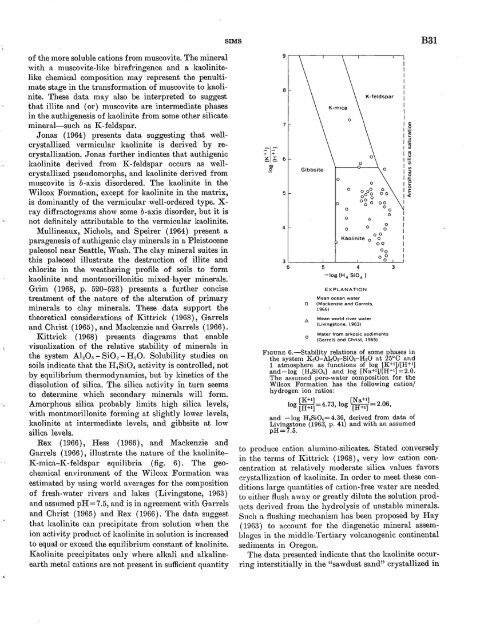RESEARCH· ·1970·
RESEARCH· ·1970·
RESEARCH· ·1970·
Create successful ePaper yourself
Turn your PDF publications into a flip-book with our unique Google optimized e-Paper software.
SIMS<br />
B31<br />
_e<br />
of the more soluble cations from muscovite. The mineral<br />
with a muscovite-like birefringence and a kaolinitelike<br />
che1nical composition 1nay represent the penultimate<br />
stage in the transformation of muscovite to kaolinite.<br />
These data may also be interpreted to suggest<br />
that illite and (or) 1nuscovite are intermediate phases<br />
in the authigenesis of kaolinite from smne other silicate<br />
minernJ-such as !(-feldspar.<br />
Jonas (1964) presents data suggesting that wellcrystallized<br />
vermicular kaolinite is derived by recrystallization.<br />
Jonas further indicates that authigenic<br />
kaolinite derived from !(-feldspar occurs as wellcrystallized<br />
pseudomorphs, and kaolinite derived from<br />
muscovite is b-axis disordered. The kaolinite in the·<br />
'~Tilcox Formation, except for kaolinite in the 1natrix,<br />
is dominantly of the vermicular well-ordered type. X<br />
ray diffractograms show some b-axis disorder, but it is<br />
not definitely attributable to the vermicular kaolinite.<br />
l\1ullineaux, Nichols, and Speirer (1964) present a<br />
paragenesis of authigenic clay minerals in a Pleistocene<br />
paleosol near Seattle, 'Vash. The clay mineral suites in<br />
this paleosol illustrate the destruction of illite and<br />
chlorite in the weathering profile of soils to form<br />
kaolinite and -montmorillonitic mixed-l'ayer minerals.·<br />
Grbn ( 1968, p. 520-523) presents a further concise<br />
trentment of the nature of the alteration of primary<br />
minerals to clay minerals. These data support the<br />
theoretical considerations of IGttrick ( 1968), Garrels<br />
and Christ ( 1965), and l\1ackenzie and Garrels ( 1966).<br />
J(ittrick ( 1968) presents diagrams that enable<br />
visualization of the relative stability of minerals in<br />
the system A1 2 0a - SiOz- RzO. Solubility studies on<br />
soils indicate that the ll1Si0,1 activity is controlled, not<br />
by equilibrium thermodynamics, but by kinetics of the<br />
dissolution of silica. The silica activity in turn seems<br />
to determine which secondary minerals will form.<br />
Amorphous silica probably limits high silica levels,<br />
with montmorillonite forming at slightly lower levels,<br />
kaolinite at intermediate levels, and gibbsite at low<br />
silica levels.<br />
Rex ( 1966), I:Iess ( 1966), and l\1ackenzie and<br />
Garrels (1966), illustrate the nature of the kaolinite<br />
I\:-mica-1(-feldspar equilibria (fig. 6). The geochemical<br />
environment of the 'Vilcox Formation was<br />
estimated by using world averages for the composition<br />
of fresh-water rivers and lakes (Livingstone, 1963)<br />
nnd assumed pfl = 7 .5, and is in agreement with Garrels<br />
and Christ ( 1965) ttnd Rex ( 1966). The data suggest<br />
that kaolinite can precipitate frmn solution when the<br />
ion activity product of kaolinite in solution is increased<br />
to equrul or exceed the equilibrium constant of kaolinite.<br />
J(aolinite precipitates only where alkali and alkalineearth<br />
metal cations are not present in sufficient quantity<br />
+ ~~~ +<br />
~~<br />
tl.O<br />
E<br />
7<br />
6<br />
5<br />
4<br />
0<br />
0<br />
0<br />
0 o 0<br />
00 ~<br />
og o 00<br />
0 00<br />
0<br />
0 6<br />
0<br />
0<br />
0 0<br />
oo<br />
Kaolinite 0<br />
0<br />
o<br />
oo<br />
Oo<br />
3~------~~----~----o~g~~<br />
6<br />
D<br />
0<br />
5 4<br />
EXPLANATION<br />
Mean ocean water<br />
(Mackenzie and Garrels,<br />
1966)<br />
Mean world river water<br />
(Livingstone. 1963)<br />
Water from arkosic sediments<br />
(Garrels and Christ, 1965)<br />
3<br />
I<br />
c:<br />
0<br />
:;;<br />
~<br />
E<br />
ctl<br />
1/)<br />
ctl<br />
~<br />
'iii<br />
1/)<br />
::J<br />
0<br />
.J::.<br />
0.<br />
0<br />
E<br />
ct:<br />
FIGURE 6.-Stability relations of some phases in<br />
the system K20-AbOa-Si02-H20 at 25°0 and<br />
1 atmosphere as functions of log [K+t]f[H+l)<br />
and-log [H 4 Si0 4 ] and log [Na+l)f[H+ 1 ] =2.0.<br />
The assumed pore-water composition for the<br />
Wilcox Formation has the following cation/<br />
hydrogen ion ratios:<br />
[K+i]<br />
[Na+t]<br />
log [H+ 1 ]=4.73, log [H+t] =2.06,<br />
and -log H 4 Si0 4 =4.36, derived from data of<br />
Livingstone (1963, p. 41) and with an assumed<br />
pH=7.5.<br />
to produce cation alumino-silicates. Stated conversely<br />
in the terms of IGttrick (1968), very low cation concentration<br />
at relatively moderate silica values favors<br />
crystallization of kaolinite. In order to meet these conditions<br />
large quantities of cation-free water are needed<br />
to either flush away or greatly dilute the solution products<br />
derived from the hydrolysis of t~nstable 1ninerals.<br />
Such a flushing mechanism has been proposed by Hay<br />
(1963) to account for the diagenetic mineral assemblages<br />
in the middle-Tertiary volcanogenic continental<br />
sediments in Oregon.<br />
The data presented indicate that the kaolinite occurring<br />
interstitially in the "sawdust sand" crystallized in
















